Amid the Soul Nebula's harsh red light, a cocoon of gas holds baby stars in the making in this ethereal new Hubble telescope image.
The Soul Nebula (also called Westerhout 5 or IC 1848) and a star-forming bubble within it
When it was taken: Sept. 29, 2023
Where it is: 7,000 light-years from Earth in the constellation Cassiopeia, in the Perseus spiral arm of the Milky Way galaxy
Source
The Soul Nebula (also called Westerhout 5 or IC 1848) and a star-forming bubble within it
When it was taken: Sept. 29, 2023
Where it is: 7,000 light-years from Earth in the constellation Cassiopeia, in the Perseus spiral arm of the Milky Way galaxy
Source






















